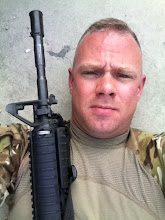I had the opportunity to fly back to Bagram Airbase yesterday and today to take care of a few errands. We left our small compound in Kabul via Blackhawk and took a 15 minute flight to the airbase up north. There I was able to exchange some uniforms that had been issued to me that I already knew were too big, but they didn't have my size at the time. I also had to pick up my NBC gear that I had mentioned earlier last month that wasn't allowed to be shipped through the USPS.
The flight was good, as I always enjoy Blackhawk rides. I'm not a fan of riding in Chinooks, and the latest deadly crash of that helicopter type just reinforced my desire not to ride in those lumbering school buses with rotors. As we flew north, I saw a lot of terrain that was familiar to me. Granted, Afghanistan is mountainous and Iraq is flat, but the village clusters of small walled compounds surrounded by irrigated and green desert was a familiar site even in a new land. These people have lived this way for a long time.
By stark contrast, the city of Kabul is massive. Not so much in land size, but suburban congestion. The city of about four million was actually designed and planned to hold about 800K people by infrastructure standards. Over the last four millennia, the city has been conquered and ruled by numerous nationalities and dynasties, each destroying and then rebuilding. I'm here as the next chapter in this city's rebirth. While flying out of the city I couldn’t help but to notice the thousands of slum areas in and around the mountains and hillside that the city has absorbed. Buildings are built on every bit of flat ground and even into the mountainside where it would support structures.
As I arrive in Bagram Airbase, I'm struck by its massive size. The last time I was here, I flew in on a fixed wing aircraft so I never saw any of the base from an aerial view. In stark contrast, I had a very good view flying in on the Blackhawk. Bagram is the largest coalition base by land size and number of personnel in Afghanistan. Quoting the exact size and strength of the base would be an OPSEC violation, so I'll just say it's huge and leave it at that. With the massive amount of real estate surrounding the air strip, they have room to spread out and expand. Which they did... Here people live in living quarter trailers, stackable dorm rooms, and plywood shacks. Not everyone has their own room, but quite a few do. The living areas are so large that they are organized into communities or villages. Then each building is numbered to help cut down on confusion of the same buildings row after row. Because of this large size, they are a bigger target for IDF, which they get hit with infrequently. Passed by a rocket casing that was still stuck in a tree. Very surreal...
There's a much better stocked PX and a huge number of concessionaires for food beverages, grooming services, and a whole host of retail shops. This whole area becomes THE social hangout for everyone after dark. The greatest thing about this place is you can walk from one end of the base to the other on the main drive, called "Disney", that runs the length of the airfield. People here gripe about how big this place is, how congested and crowded it has become, and having to walk such far distances to get anywhere. But I bring a different perspective to this place, not having the extra niceties, social hangouts, or even a nice length of ground just to stretch your legs. This time I've walked a mile in their shoes and my judgment is to quit your complaining.



No comments:
Post a Comment
Your comments will be logged and reviewed for appropriateness.